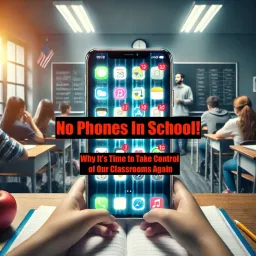No Phones in School!

No Phones in School: Why It's Time to Take Control of Our Classrooms Again
In the ever-evolving landscape of education, technology has undoubtedly played a transformative role. Smartboards have replaced chalkboards, laptops have substituted notebooks, and digital assignments have become the norm. These advancements have opened up new avenues for learning and expanded the horizons of what's possible in education. However, amid these positive changes lies a significant challenge—one that has become an uncontrollable force of interruption and distraction: cell phones. As beneficial as smartphones are in our daily lives, they have no place in the classroom. It's time to put an end to their presence during school hours. This isn't a battle against technology as a whole, but a fight to reclaim the focus, discipline, and social interaction that the school environment is supposed to foster. Let's delve deeper into why banning phones in schools is not only necessary but crucial for the future of education. The Digital Distraction: A Modern Epidemic It's no secret that phones are designed to demand our attention. The average smartphone user checks their device 58 times a day, with 30 of these checks happening during work hours. If we translate this to a school environment, we're looking at dozens of potential interruptions during crucial learning time. Notifications, social media, games, and messaging apps make it nearly impossible to ignore the urge to glance at the screen, even when there are more important things happening around us. The dopamine rush associated with receiving likes, comments, or messages creates a cycle of addiction that's particularly potent for developing brains. If adults, with fully developed prefrontal cortexes (the part of the brain responsible for decision-making and impulse control), struggle to maintain focus with a phone nearby, how can we expect children and teenagers to resist? The adolescent brain is particularly susceptible to the allure of immediate gratification, making the presence of phones in classrooms even more problematic. The classroom is meant to be a sanctuary for learning, but instead, it has become yet another place where phones rule the day. Students are bombarded by text messages, Snapchats, TikToks, and Instagram alerts. Rather than focusing on algebra or history, they're more invested in likes, comments, and streaks. The brain, unable to multitask as effectively as we think, cannot process the flood of information from a screen and retain classroom knowledge simultaneously. The Myth of Multitasking: Why Phones Are Killing Focus When a phone buzzes or lights up, it's a natural instinct to check it. This instinct is so ingrained that even when we actively try to ignore our phones, our cognitive resources are depleted by the effort of not checking them. A study published in the Journal of the Association for Consumer Research found that the mere presence of a smartphone reduces available cognitive capacity and impairs cognitive functioning, even when people feel they're giving their full attention to the task at hand. Even if students turn off notifications, the temptation to scroll during a lecture is overwhelming. Research consistently shows that the mere presence of a phone, even if it's not in use, reduces cognitive capacity. The brain is expending energy by actively ignoring the phone, rather than being 100% committed to the lesson at hand. The human mind wasn't built to juggle constant interruptions, and the way smartphones are engineered only exacerbates the problem. Notifications, instant replies, and social media apps are all designed to trigger dopamine, the brain's pleasure chemical, making them addictive by nature. Students end up in a constant loop of checking their devices, even if they don't want to, simply because their brains are wired to crave the reward of seeing something new on the screen. In a classroom setting, where focus and engagement are paramount, this kind of distraction wreaks havoc. Students who are checking their phones aren't just disengaged from their own learning—they're also likely to disrupt the focus of those around them. A study published in the journal Educational Psychology found that students who didn't use their phones wrote down 62% more information in their notes, took more detailed notes, were able to recall more detailed information from the lecture, and scored a full letter grade and a half higher on a multiple choice test than those who were actively using their phones. The Undeniable Impact on Academic Performance The correlation between phone use in class and academic underachievement is undeniable. Several studies have shown that schools with strict phone bans see an improvement in test scores and overall academic performance. For example, a study conducted by the London School of Economics revealed that schools that banned cell phones saw a 6.4% increase in test scores—equivalent to adding five extra days to the school year. The impact was even more significant for low-achieving students, who saw an increase of 14.23% in their test scores. Allowing phones in the classroom creates a fragmented learning experience. Students are often half-engaged, distracted by the lure of their devices, and missing key parts of the lesson. Over time, this compounds, leading to knowledge gaps that are hard to fill. The argument that phones can be used for educational purposes is weak when we consider that the vast majority of in-class phone use is social or recreational. A study by Common Sense Media found that only 3% of the time teens spend on their phones is used for learning or creating content. Moreover, the constant availability of information at our fingertips can lead to a false sense of knowledge. Why bother memorizing facts or learning problem-solving skills when you can just Google the answer? This reliance on phones as external memory banks is detrimental to the development of critical thinking skills and deep understanding of subject matter. Beyond Academics: The Social and Developmental Costs Beyond academic concerns, phones are also eroding the social fabric of schools. Before smartphones, school was a place where students learned to navigate social situations—where they built friendships, worked on group projects, and developed interpersonal communication skills. Now, many students are glued to their screens, even during lunch breaks or downtime, missing out on the valuable face-to-face interaction that is crucial for their emotional and social development. The ability to read facial expressions, interpret tone of voice, and engage in real-time, unscripted conversations are skills that are developed through practice. When students are constantly engaged with their phones, they miss out on opportunities to hone these crucial social skills. A study published in the journal Computers in Human Behavior found that students who spent more time on their phones were less able to interpret emotional expressions and showed less empathy towards others. Instead of building meaningful connections with their peers, students are immersed in the shallow world of social media. They communicate through emojis, likes, and shares rather than real conversations. Schools, which should be cultivating emotional intelligence and social skills, are instead filled with students who are more isolated than ever. A survey by the Pew Research Center found that 54% of teens believe they spend too much time on their cell phones, and 41% say they spend too much time on social media. Phones also fuel a sense of exclusion. Students often feel pressure to showcase a perfect online life, which can foster anxiety, depression, and low self-esteem, particularly among those who struggle to keep up with the constant stream of comparisons. By banning phones in schools, we can help limit the negative effects of social media and reintroduce a culture of real, face-to-face interaction. The Mental Health Crisis: Phones as a Contributing Factor The mental health of our youth is in crisis, and while phones are not the sole cause, they are undoubtedly a contributing factor. Social media platforms are built on metrics of validation—likes, followers, and comments. For young, impressionable minds, this creates a vicious cycle of needing constant approval. Students are no longer attending school just to learn; they are there to document their lives for their peers, hoping for digital validation. The mental health implications of this are profound. Research shows a direct link between high smartphone usage and mental health issues such as anxiety, depression, and loneliness, especially in teenagers. A study published in the Journal of Abnormal Psychology found that from 2010 to 2015, rates of depression among teens increased by 33%, with smartphone use cited as a major contributing factor. While some may argue that banning phones in school won't solve these problems, it would at least provide a break from the incessant pressures of social media. Schools could become sanctuaries from the relentless barrage of online comparisons, cyberbullying, and the constant need to be "on." A study published in the journal Cyberpsychology, Behavior, and Social Networking found that taking a break from Facebook led to lower cortisol levels and increased well-being among participants. Removing phones from the school environment would allow students to focus more on their inner development and emotional well-being, rather than obsessing over their online personas. It would also encourage them to seek validation through real, meaningful accomplishments rather than through social media metrics. Addressing the Safety Argument: Finding a Balance One of the most common counterarguments to banning phones in school is the safety concern. Parents want to know they can reach their children in case of an emergency, and phones provide a direct line of communication. While this is a valid concern, t































